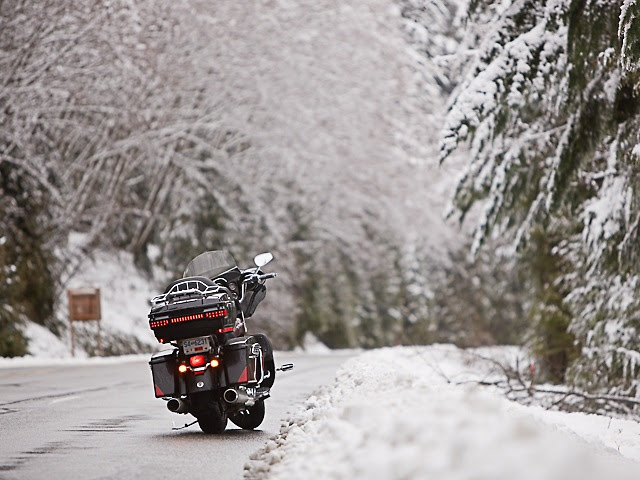
How to Winterize Your Motorcycle

For many motorcyclists across the country, the end of fall marks a crucial maintenance time for their cycles. Some fortunate riders enjoy year round suitable cycling climate. If you are not one of the fortunate, you need to follow a few important steps to protect your cycle over the winter months ahead. The following steps are helpful guidelines to assist you in winterizing your motorcycle to assure come spring, you can get back on the road with little trouble.
1. Gather up the tools necessary for winterizing your bike. You will need, cleaning cloths, spark plug wrench, a trickle battery charger, four or five quarts of high quality oil, new oil filter, oil can or device to get oil in the cylinders, chain lube (if you have a chain drive), fuel stabilizer, spray can of WD40, a breathable motorcycle cover, kitchen plastic wrap, rubber bands, vinyl or plastic gloves, items to clean and wax your bike. Lastly a nice location for the bike to spend the winter, a heated secure garage would be ideal. Avoid wind, dripping water, vermin, mildew, and chemical fumes.
2. Give your bike a thorough cleaning. A gentle wash detergent and water will suffice. By removing road grime and insects you will protect the finish of the bike. Avoid spraying water directly into the opening of the muffler. If baffles get wet and are not dried prior storage, internal rust could result. Likewise avoid moisture in the air cleaner housing. If the housing becomes saturated, it could act as a choke, making cycle difficult to start. Dry completely with a good chamois. Clean and polish all aluminum and stainless surfaces with the appropriate metal polish. Finally finish up with a coat of good wax polish on all painted and chrome surfaces. Clean the chain (if you have one). Spray off all the built up residues with WD40. Lube the chain.
3. Add a fuel stabilizer to the gas tank. Fill your tank with gas as full as it can go. This is very important. As fuel ages, more volatile components tend to change, leaving sludge and gummy substances that can affect the carburetor. Run the bike so the gas and fuel stabilizer get to the carburetor and fuel injectors then turn off the fuel and run it dry.
4. If you have a carburetor, drain your float bowls. Shut off the gas petcock and drain the gas from the carburetor bowls. Consult your manual for location of drain screws. Of course if you have a fuel-injected bike, there isn’t anything to drain.
5. Once the engine is warm, you can change the oil and filter. Oil chemistry changes over periods of extended storage. Old oil can develop acidic qualities, which can corrode engine parts.
6. Using an oil-squirting device, put oil over the stationary tubes on the front forks. Get on the bike, hold the front brake and bounce the bike up and down to work the front suspension. This will keep the rubber seals from drying out and protect the exposed fork tubes.
7. Remove spark plug wires, and carefully with a spark plug wrench remove the plugs. With your oil-squirting device, get some motor oil in the cylinders. Approximately one teaspoon of oil will work well. Tuck the plug wires away somewhere safe so they do not arc, then spin the motor with the starter for a few revolutions to get the oil spread around. Remember to keep your face away from the spark plug holes. Oil will squirt out! Clean and gap the plugs and put them back in. Replace plug wires.
8. You may want to remove the battery. Some batteries may require charging every four weeks with a “Battery Tender” type of charger. Built up sulfates on the plates can ruin a battery during cold storage and inactivity. A thin coat of Vaseline to the terminals on the battery can prevent corrosion. This small step will mean an easier spring start up and no extra cost of battery replacement.
9. If your bike has a liquid cooling system, check it’s level of anti-freeze with a hygrometer. Drain, flush and replace antifreeze if necessary. We suggest this replacement be done every two years. Do not leave the antifreeze level low or empty, this could lead to rust or corrosion of the cooling system. Check all other fluid levels at this time.
10. Lube your cables. Lube suspension and pivot points. Lube the drive shaft (if you have one). Check the air cleaner and the fuel filter. Look at brake pads. Give your bike a good once over.
11. Clean and treat all leather with a high quality dressing.
12. If your storage location is bare concrete, we suggest using a piece of plywood, MDF, or old thick carpet. This will insulate the bike from becoming damp. We also suggest storing your bike with all the weight removed from the wheels. A bike stand or some blocking works if you have a wheeled lift. A center stand and some blocking will work too. Do not store your bike near any ozone emitting devices, such as motors, freezers, furnaces or electric heaters. The gasses created by the above will deteriorate rubber parts.
13. With a clean cloth, wipe good quality light machine oil over all the metal surfaces, except the disc brakes. Spray a little WD40 in the tail pipe(s). Cover your tail pipe opening and the air intake with plastic wrap and a rubber band. You can also cover drain hoses as well. This will prevent any opportunistic pests from making a cozy winter home in your bike.
14. Do not run the engine for short periods of time over the storage period, this can lead to condensation due to engine and combustion byproducts in the oil.
